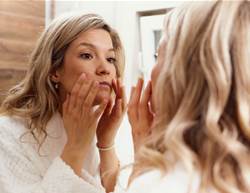You probably already know a lot of skin cancer basics, like the fact that you’re at higher risk of developing it if you spend a lot of time in the sun, and that you should watch your moles for any suspicious changes in colour, shape or size (among other skin cancer symptoms). But something you might not be aware of it just how common skin cancer is.
There are three major types of skin cancer—melanoma, basal cell carcinoma and squamous cell carcinoma—and it usually develops in the places most frequently exposed to the sun, like your face, scalp, neck and chest. These skin cancers occur when mutations, or errors, occur in your skin cells’ DNA, and they cause the cells to grow uncontrollably into a tumour.
While exposure to the sun’s harmful ultraviolet (UV) rays is the top cause of skin cancer, you’re not necessarily in the clear just because you didn't spend your teenage years living in a tanning bed or frying yourself in baby oil. Here, eight other potential skin cancer causes—and what you can do to reduce your risk.
Getting even one bad sunburn
Just one blistering burn can double your risk of developing melanoma later in life, according to the Melanoma Research Foundation. And getting a severe burn on your torso may be especially likely to lead to melanoma down the road, according to research from the American Journal of Epidemiology.
There's no real way to reverse the damage that's already been done, but you can help protect your skin from future burns (and prevent your melanoma risk from rising even higher) by faithfully slathering on sunscreen, says Dr Whitney A. High. Regular daily use of an SPF 15 or higher sunscreen lowers the risk of developing melanoma by 50%.
Having fair skin
Melanin is the pigment that gives skin its colour; the darker your skin, the more melanin you have. Melanin provides some protection from the sun’s damaging UV rays, so if you’re naturally pale, then you’re more likely to burn—and are therefore much more likely to develop skin cancer than a person with darker skin. That said, don't assume you're safe if your hair and complexion happen to be darker. "Darker-skinned people are much more susceptible to acral lentiginous melanoma (ALM), an especially virulent form of melanoma that typically appears on the palms of the hands and soles of the feet," explains dermatologist Dr Bruce Robinson. The bottom line: Regardless of your skin colour or type, it pays to be proactive. Do a monthly skin check, and make sure you carefully check any suspicious spots on your hands, soles of your feet, or under your nails. These need to be seen by a derm, pronto.
Being a ginger
The same genetic mutation responsible for red hair also increases melanoma risk, according to a 2013 study done at Beth Israel Deaconess Medical Center in Boston. The researchers found that a certain mutation, MC1R-RHC, activates a cancer-causing pathway when someone with red hair is exposed to UV radiation. (The same pathway is also linked to breast, ovarian and lung cancer.)
Living in the mountains
If you reside in the mile-high city of Armidale you're more likely to develop melanoma than someone who lives closer to sea level. The problem, as with airplane travel, is elevation. "Most people assume your skin cancer risk only goes up the closer you get to the equator, but higher elevations are dangerous, too," explains Dr. Robinson. Not only does the amount of UV radiation increase, but the thinner air up there doesn't absorb UV waves very effectively—which means it's more damaging to your skin cells. Still skeptical?
Having a family history of skin cancer
If your parents or a sibling has had skin cancer, then you’re 50% more likely to get it yourself than people who don’t have a family history of the disease.
Flying frequently
Pilots and flight attendants are twice as likely to develop melanoma, compared with the general public, according to a 2014 study. "Most people don't realise that for about every 3,000 feet you climb, there's a 15% increase in intensity of UV radiation," explains Robinson. That means that at 30,000 feet—where most commercial aircraft fly—the UV level is about twice that of ground level. And while the plane's structure affords some protection, UVA rays (which are even more intense when flying above clouds or snowy mountains) go right through the windows. Applying a broad-spectrum sunscreen (which protects against both UVA and UVB rays) with an SPF of at least 30 before getting off the ground should help.
Driving a lot
About three-quarters of melanomas in situ (early-stage melanoma that hasn't yet spread) are on the left side of the body, according to a 2010 St. Louis University School of Medicine study. Researchers suspect it's from UV exposure while driving; while glass effectively blocks UVB, cars' side windows allow 63% of UVA to get through. Men are even more likely to have left-sided skin cancers than women are, possibly because some of the older women studied were primarily passengers rather than drivers. One option is to treat your car to transparent window film, which screens out UVB and UVA without reducing visibility (when shopping for products, check to make sure it has the Skin Cancer Foundation's Seal of Recommendation). Or make sure you're always slathered up with a broad-spectrum sunscreen before you hop into your car, even on cloudy days.
Exposure to certain chemicals
Arsenic exposure has been linked to several types of cancer, including skin cancer. Though many uses have been discontinued in the United States, it was once a common ingredient in many pesticides and herbicides, and was used in pressure-treated wood. If you ever lived near or worked at a smelter, or a farm that used arsenic pesticides, then you may be at elevated risk for skin cancer.
(Want to pick up some healthier habits? Sign up for FREE to get healthy living tips, weight loss inspiration, slimming recipes and more delivered straight to your inbox!)










